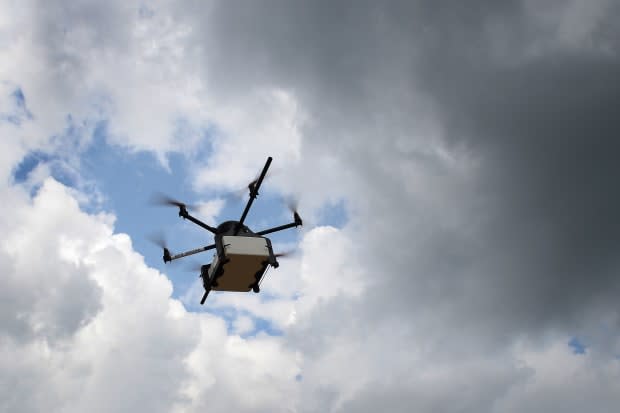Hey, Quick Question: Is Drone Delivery Coming for Fashion?
A new study out of Canada may have the answer, but it also may not be what you want to hear.

Welcome to our column, "Hey, Quick Question," where we investigate seemingly random happenings in the fashion and beauty industries. Enjoy!
There was a moment maybe, like, three years ago when fashion was very heavily intrigued by drones. The verb used here is intentional: I wouldn't go so far as to say "obsessed with," because one runway show with drone "models" — whirling slabs of machinery clutching bags in their robot talons — does not an infatuation make. But the intrigue was abundant: Many a think piece declared drones to be "the future" of fashion and retail, referencing megaliths like Alphabet and Amazon that were — are — actively testing drone deliveries, like it's already 2045 and we have both flying cars and a woman president.
It's been almost exactly two years to the day since that drone runway show, and I can say with absolute certainty that a drone hasn't delivered one of the several 60%-off jumpsuits I've purchased since. With fewer developments being made in drone technology and governmental regulations on the whole, I think it's safe to say that fashion's intrigue, not obsession, has waned.
A few weeks ago, however, we at Fashionista came across a new study that bubbled the topic back up to the top of our inboxes. In new research from the journal Transportation Science, the Maryland-based Institute for Operations Research and the Management Sciences (INFORMS) set out to find just how realistic drone delivery is as an option to changing consumer delivery demands. We want what we want, and we want it now, and luxury e-tailers are churning out increasingly efficient shipping options — Net-a-Porter offers same-day delivery to select locations, for instance — to give us everything we want.
As the conversation around sustainability becomes a bigger and more mainstream piece of the industry's lexicon, drones are an admittedly sexy alternative for both brands and consumers becoming more conscious of their respective carbon emissions. According to research recently published in the journal Nature Communications, drones consume less energy per kilometer in delivering a package than trucks do, so drone delivery could help retailers dramatically cut back on CO2 emissions.
"Results suggest that, if carefully deployed, drone-based delivery could reduce greenhouse gas emissions and energy use in the freight sector," wrote researchers. "To realize the environmental benefits of drone delivery, regulators and firms should focus on minimizing extra warehousing and limiting the size of drone."
So could drones be the answer to the faster delivery experience and the heightened environmentally friendliness we definitely, undoubtedly and unabashedly want? According to INFORMS, the answer isn't exactly a hard yes, but it's not a solid no, either.
The study, conducted by Associate Professor Fatma Gzara and Ph.D Candidate Gohram Baloch at the University of Waterloo in Ontario, Canada, found what we kind of already know: Demand for drone delivery across retail is quite high, but the actual ability to meet that demand is correspondingly low.
Rather than testing live drones, Gzara and Baloch instead worked with data affecting New York City, where Amazon debuted its two-hour delivery services back in 2014. From there, the authors analyzed tradeoffs between distribution costs and revenues under what they call "varying social difficulties" including customer preferences, as well as regulatory and technological limitations. They then made all sorts of projections, from how many drone facilities to open to which delivery services should be made available to consumers in certain parts of Manhattan.
Gzara and Baloch analyzed three drone facilities that covered 75% of New York City, and just 34% of the population; opening a fourth facility increased area and population to 84% and 38%, respectively, but the pair found that "the increase in operation cost is not enough to cover the facility costs."
And therein lies the issue with drone delivery, at least for now: "Our results show that government regulations, technological limitations and service charge decisions play a vital role in optimal configurations and drone target markets," reads the report. For a retail company to provide effective drove delivery to the remaining 60-odd% of the population, the answer isn't simply to wrangle up more drones. That's because, unfortunately, the market just...isn't there.
Current drone landing capabilities are extremely limited for a whole slew of reasons. On the legislative side, for instance, the drone industry is still something like a Wild Wild West. In January, the Federal Aviation Administration proposed new federal rules that would more closely monitor drones in flight — raising new questions about drones being used for commercial use. That would be even more problematic for a densely populated area like Manhattan, where demand for drone delivery is "expected to be high."
But what about somewhere less crowded but still fashion-hungry, like Dallas, Miami, or even Los Angeles? Even that's still a big "if," for consumers and retailers alike. But research finds there's still ways for more committed brands to test drone delivery, only among more specific markets. "Under the right circumstances, e-retailers can reach smaller markets and more price-sensitive customers by possibly offering discounts on drone-delivered orders," writes Gzara.
It looks like the answer to this headline is a big, fat and dissatisfying "maybe." But when it finally comes time to welcome our new robot overlords, toting Jacquemus micro-bags and Loewe trench coats (or whatever the hot-ticket item is by then), I imagine that fashion will bump its intrigue up to an obsession — or even, eventually, to reality.
Never miss the latest fashion industry news. Sign up for the Fashionista daily newsletter.

